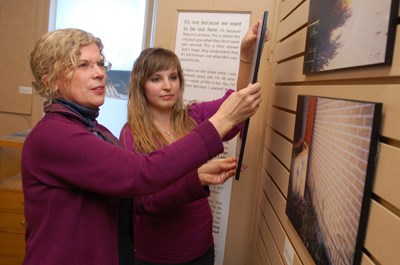Shauna is a homeless woman with a terminal illness.
She doesn't want to spend the last part of her life curled up on a chair at the Elgin Street Mission or sleeping on a spare bed in a friend's house. Shauna wants someplace to call her own.
“I don't want to die in the street,” she said. “I want to die in my home.”
Shauna, like the other 13 homeless or nearly-homeless Sudbury residents who took part in Laurentian University's Poverty, Homelessness and Migration project, did not give her full name due to academic research ethical standards.
The participants were given disposable cameras and asked to snap shots of their living spaces.
A collection of the photographs is currently on display at Artists on Elgin, and will be until May 14.
Carol Kauppi, director of the project, said the goal of the art exhibition is to “enable people to see and witness firsthand what it looks like to live in these kinds of circumstances.”
“Many people really don't have a good understanding of what it means to be homeless,” she said. “These photographs allow people to step inside the world of homeless people, and also people who are living in substandard or precariously housed situations.”
Once the participants returned their cameras, they were asked to reflect on the content of the images.
Shauna wasn't the only one with an “ eye-opening” story to share.
People like Wolfe shared stories of living under trailers and other makeshift shelters.
“It's like you almost have to be half-human to survive out there,” he said. “Well, you have to half-human, half-animal.”
Some participants like Nita have places to stay, but don't feel comfortable in them. Fear keeps her from opening her bedroom window.
“I don't know who could be climbing through,” she said. “I can't hear if I'm sound asleep, so my fear is of anyone climbing in. I just don't feel safe.”
Kauppi said the participants were eager to share their photos and their stories.
Most people living on the streets and in substandard housing aren't regularly given the opportunity to inform the community of what their lives are like.
“They were extremely pleased to have us approach them and want to hear their stories, and want them to show us their living circumstances,” Kauppi said. “We've found the response was very enthusiastic. Our participants have actually said to us in the interviews: 'I've taken these photographs. Show these photographs. Let the people of Sudbury see what the circumstances are like.'”
The art exhibition is only a small part of a bigger project Kauppi is heading. She is working on a five-year project, studying homelessness in 10 northern communities. She said the broader goal is to look at the reasons “that underlie deep poverty and homelessness.”
Melissa Sullivan, an MSW candidate and research assistant working on the project, said “to see life through someone else's eyes is just a really good experience.”
She said working on the project still hasn't conditioned her for the things she has seen.
“I know what the reality is, and seeing it is still shocking to me,” she said.
To protect the identity of the participants and to comply with research ethics, Kauppi said they had to be identified by their “street names” only.
